Master Workday Training in Hyderabad’s Leading Experts
Workday HCM Training in Hyderabad
Workday HCM and Enterprise Interface Builder
An integral element of Workday HCM, the Enterprise Interface Builder (EIP), offers users an intuitive solution for developing secure integrations between Workday HCM and external systems such as Salesforce or SAP HANA.
Integrations between software applications are crucial in modern enterprises and Workday HCM offers an easy, guided interface through EIP to define both outbound and inbound integrations.
Outbound integrations send information from Workday HCM to an external system, while inbound ones bring it back inbound to Workday HCM. The direction of data flow always refers to Workday HCM as its source.
If you’re aiming to become proficient in these processes, Workday HCM Training in Hyderabad provides targeted guidance on building EIPs.
Components of Workday HCM's EIP Design Pattern
Let’s break down Workday HCM’s EIP design pattern into its three core components – collecting data, optionally transforming it, and sending the results onward.
Extract, Transform and Deliver is at the core of EIP functionality in Workday HCM. Consider EIP as a precision tool – for instance if all your data resides within one custom report or can be managed using only a web service call, EIP may be just what’s needed for processing purposes.
Workday HCM’s EIP excels when managing single data sources. When should you consider Workday HCM’s EIP as the ideal solution?
Do your data fit within one custom report, one transformation and integration need only one input and output?
If your answer to any or all these questions was “yes”, Workday HCM’s EIP might be just what’s necessary; otherwise, it might not.
In more complex scenarios however, Workday HCM EIP might not provide all the features that meet them all.
Alternatively, other tools might provide better support if your needs involve retrieving data from multiple sources or performing numerous transformation steps.
For anyone preparing to handle both simple and complex integrations, Workday HCM Training in Hyderabad offers valuable, hands-on experience.
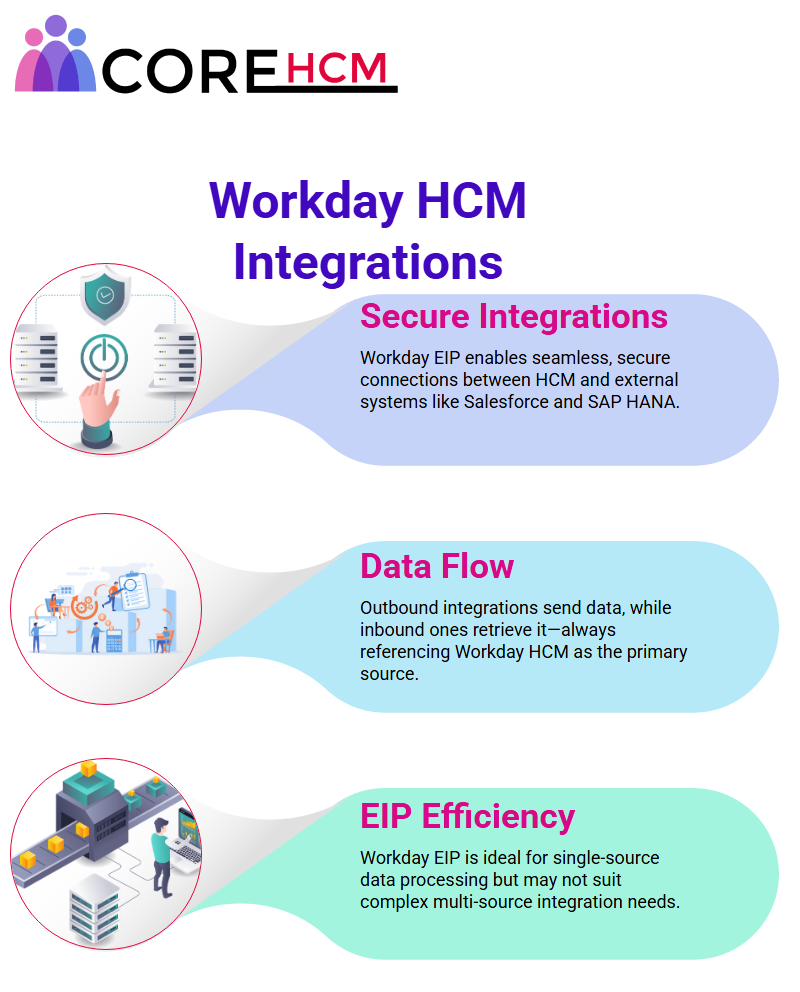
Navigating EIP in Workday HCM
Although Workday HCM’s EIP may have limitations, it remains widely utilized. It excels in scenarios requiring simplicity and precision while its user-centric design prioritizes efficiency which makes it a popular option when integrated within Workday’s ecosystem.
Keep this in mind when thinking about Workday HCM EIPs; its purpose is to balance inputs, transformations and outputs so as to enable seamless data flow between systems.
Although limited by design constraints, EIP still serves an integral purpose when connecting Workday HCM with external platforms and systems.
Staking out Workday HCM and EIPs may prove critical in successfully connecting Workday HCM with third party applications and services.
Despite any shortcomings they might pose though, EIP remains key when connecting Workday HCM with others systems and integrating Workday HCM with external systems understanding both can play vital roles when connecting Workday HCM with external systems as it integrates.
EIPs are essential components of Workday HCM ecosystem. Their straightforward but powerful nature accounted for 77% of integrations built so far.
Simple integrations like these make Workday HCM successful and widespread, so let me walk through how they function and why they’re essential components of HR software solutions like Workday HCM.
If you’re looking to specialize in these areas, Workday HCM Training in Hyderabad can be a solid foundation.
Outbound EIPs in Workday HCM
Next, we have Outbound Enterprise Information Pipelines. These allow users to extract data from Workday HCM for processing by either attaching it back into Workday or forwarding to external systems for further use.
Its versatility enables it to easily integrate with external systems for seamless data exchange.
Workday HCM Training in Hyderabad can help learners master the techniques of setting up and testing outbound integrations.
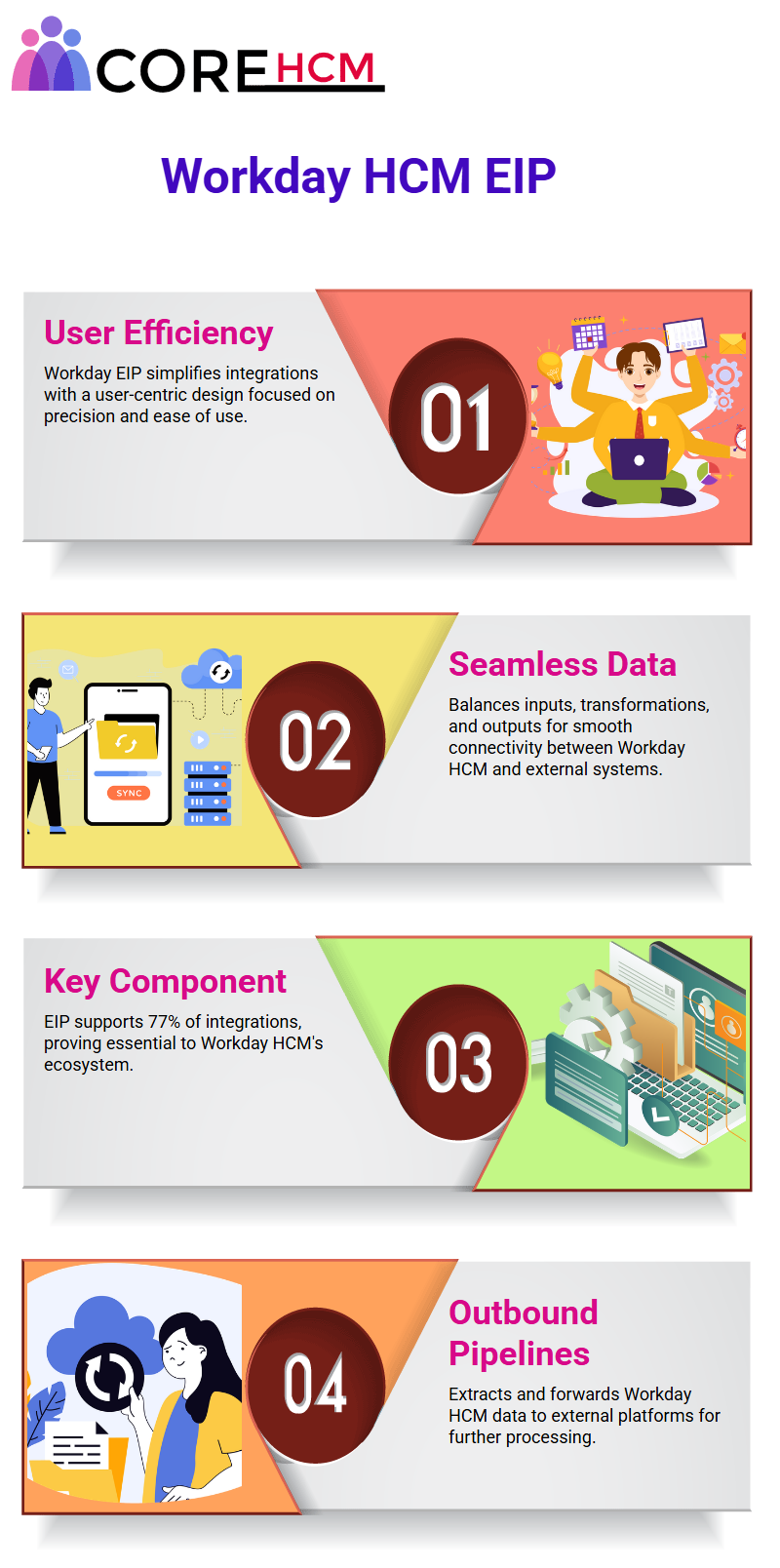
Employee Interest Plans in Workday HCM
An EIP data source in Workday HCM may come in either the form of custom report data or Workday Web Services (WWS).
Custom reports are often the go-to solution when creating HCM reports; however, for optimal use they must first be web service enabled under the Advanced tab.
Without this configuration step in place, custom reports cannot be integrated within Workday HCM.
Workday Web Services offer another solution, comprising around 30 distinct services tailored to various functional areas in Workday HCM.
Operations like “put” for uploading data and “get” for reading it provide reliable ways of connecting and interacting with Workday HCM.
For those entering roles that involve technical Workday responsibilities, Workday HCM Training in Hyderabad can offer focused learning on these data source options.
Workday HCM EIPs
At their core, EIPs in Workday HCM are powered by web services built upon XML markup language that are integral parts of seamless data exchange processes and provide seamless data flows between integration processes.
Workday HCM relies on modern technologies for reliable data exchange; from custom reports and WWS integration processes, to data migration services like IFTTT or FTP servers.
Professionals taking Workday HCM Training in Hyderabad will gain deeper knowledge of these web service-based integrations and the underlying architecture.
Workday HCM Overview on web services
Let’s dive deep into Workday HCM and its web services! For anyone curious to understand how Workday HCM helps manage human resources operations more efficiently, this will surely prove informative!
Workday HCM offers powerful web services designed specifically to serve HR and staffing functions efficiently and cost effectively.
These web services aim to simplify complex processes and increase productivity, with Workday HCM being an especially versatile system in this regard.
As someone familiar with Workday HCM, its versatility should not be overlooked when considering all its functions and integration capabilities.
As a consultant specializing in integrations, Workday HCM makes perfect sense; but from a functional perspective there may not be as much of an imperative to get deep into Workday web services’ details perhaps more pertinent will be custom reports and outbound web services than any of those innermost layers of code that make Workday possible.

Role of Web Services in Workday HCM
Web services play an essential part when processing inbound EIPs into Workday HCM. Custom reports won’t do; public web services must be relied upon instead in order to get this task completed successfully.
Workday HCM excels at developing outbound EIP integrations. Setting one up is simple – navigate to Workday, launch its proxy server, and click ‘Create EIP’ from within Workday HCM.
Name it accordingly (i.e. INT WW EIP), as well as specify its direction; an outbound EIP named Employee Details Outbound makes it simple for staff and stakeholders alike to quickly identify its purpose and type.
Creating an Integration in Workday HCM
Creating integrations easy thanks to its guided interface, making integration creation effortless.
Once you get going, configure three essential steps – Get Data, transform it and deliver it – as the backbone for your integration process.
It makes accessing data easy through custom reports or web services, both of which offer user-tailored solutions tailored specifically for each organization’s unique requirements.
Custom reports often feature calculated fields to meet these demands.
Be sure to enable web services for these reports so they’re easily accessible; otherwise, they might become inaccessible and cause headaches for HR administrators.
Workday HCM Training in Hyderabad provides detailed exercises on integration creation, guiding learners step-by-step through building these data pipelines.

Streamlining Reports with Workday HCM
Have you been experiencing difficulty accessing reports within Workday HCM? Perhaps they weren’t set up as web services; in that instance, access would likely have been restricted until this was addressed.
Created a great report, but when it came time to use it you couldn’t access any of its data? Why is that? Simply because it wasn’t set up as web service.
Today we provide you with a guide for fixing this. Here we demonstrate how to enable custom reports within Workday HCM as web services so they run without issue every time.
Workday HCM Training in Hyderabad sessions often include case studies where students resolve access issues related to misconfigured reports.
First, find your employee details report. Open and edit its custom report; make any necessary edits; edit as necessary (some reports can have redundant fields; for instance: Experience Maths Evaluation Expression and LRB); keep only one, remove others (for instance ‘Experience Maths Evaluation Expression” was redundant in three fields offering similar information)
Optimizing Web Services in Workday HCM
Once your report is in its final shape, head to the Advanced tab where there will be an option named ‘Web Services Options” where you can enable it as a web service in Workday HCM.
At the point where you choose this, two fields will become visible; these being: Web Service API version and namespace.
Workday HCM Training in Hyderabad teaches you how to choose appropriate API versions and namespaces for optimal integration results.
Choose the latest API version available in your tenant to achieve optimal performance; however, if backward compatibility is paramount you might opt for an older version; though I wouldn’t advise it.
Always opt for the latest version when possible and never underestimate the significance of namespace identifying reports within their tenants.
It will often do this automatically for you by replacing spaces with underscores to keep its structure compliant with XML standards.
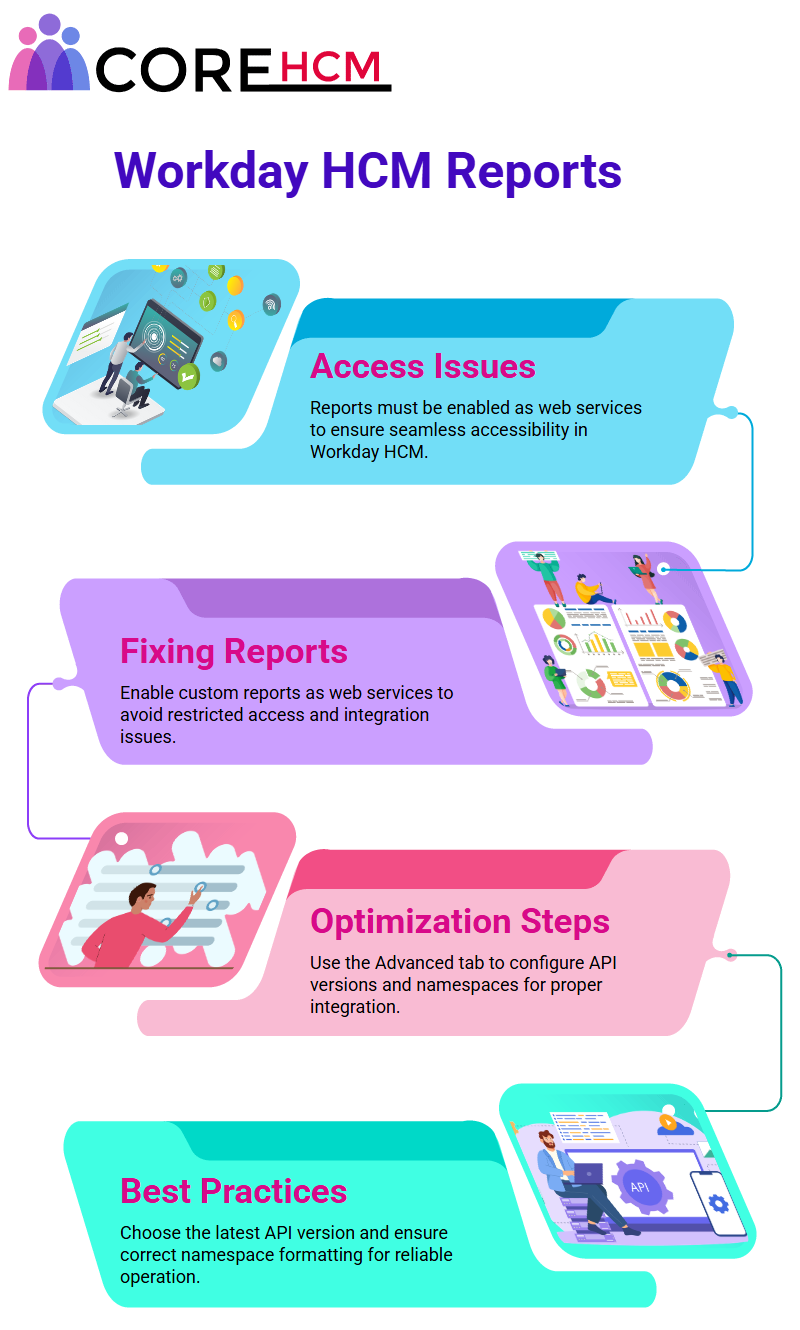
Handling Errors in Workday HCM Reports
Now let’s save our report. If errors do appear, don’t panic; for instance, when tried saving web service enabled report, received an alert that indicated fields Worker Types and Prompt Qualified Combination were missing in Prompt Step Default Grid on Prompt Steps grid on prompt Steps grid.
To address the problem, the prompts were accessed and any undefined prompt defaults filled in, while also disabling ‘Do Not Prompt at Runtime’ option as it wasn’t needed each time it would pop up.
Important Considerations for Workday HCM Reports
One key point when saving reports in Workday HCM should be keeping in mind the report format and column heading overrides.
Workday HCM Training in Hyderabad emphasizes these critical details during hands-on reporting labs to reduce future troubleshooting.
Workday HCM automatically converts spaces that contain text into underscores to keep everything running smoothly and ensure that there are no delays due to incomprehensible text files.
Although it might seem minor, such an action helps ensure everything runs efficiently and keeps employees’ content with their employer’s policies and benefits programs.
So, the next time you create a report in Workday HCM, double-check these fields, formats, and settings these simple tweaks could save a great deal of hassle later! Simply ensure everything is set up appropriately before getting going all will go smoothly from then on out!
Enhancing Field Readability in Workday HCM
Workday HCM offers an easy and straightforward method for you to adjust field names so they are easier to read; spaces in field names will automatically be converted to underscores for ease of display.
It handles special characters like hashes (#) seamlessly, converting them to formats compatible with XML to avoid conflicts between systems.
Workday HCM Training in Hyderabad helps clarify these transformations by demonstrating how fields behave in integrations and output formats.
XML Name can then be updated accordingly for clarity purposes as you make updates like these to enhance field clarity further.
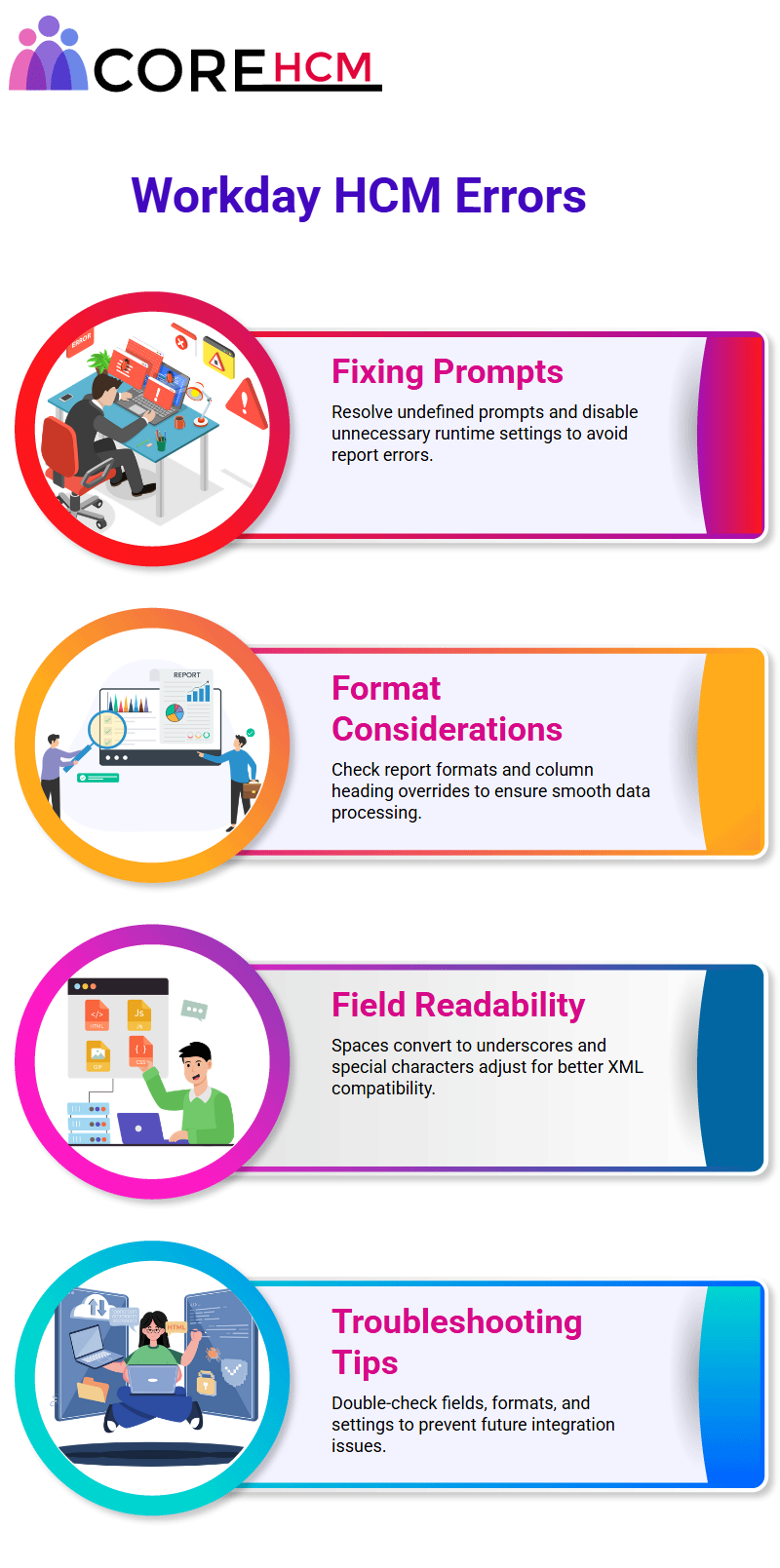
Web Service Compatibility Workday HCM
Workday HCM makes every detail more readable and usable by offering fine tuning options to each detail, improving readability and usability for every user.
It makes web service-enabled report creation an effortless task, providing clear prompts and options to make this task effortless.
Once configured, these reports appear as valid data sources ready for integration into Workday HCM systems.
Starts works to enforce restrictions that limit field name length to 16 characters or less to reduce potential issues while optimizing file sizes for greater performance.
Delivering Data Effectively in Workday HCM
Workday HCM offers multiple delivery methods for sending files directly to end systems; one such approach is Secure File Transfer Protocol, more commonly referred to as SFTP.
Setting up an SFTP in Workday HCM involves configuring server information such as host name, port number, username and password for file delivery purposes.
You may also specify certain directories and folders for delivery of files.
Workday HCM Training in Hyderabad gives Learner’s exposure to real SFTP configurations used in live environments.
Helps to make configuring Secure FTP Transfer (SFTP) simple. Simply input the server details, starting with “sftp://”, to establish secure connections and complete setup to create reliable secure transfers of your data to meet business needs.
Whilst setting up secure transfers with Workday HCM can be complex and time consuming.
Here is How Secure Transfers Work with Workday HCM
Step one in setting up secure file transfers in Workday HCM involves providing the host name. For simplicity’s sake, the format should be as follows: sftp://secureftp.adp.com if using port 22 by default you don’t need to specify this field.
However, for non-default ports like 10022 you will have to specify them by copying and pasting this setup into Workday HCM’s SFTP address field.
As soon as this step has been completed successfully, you should configure the directory. This folder serves as the central hub for sending files between Workday HCM and SAP HANA, acting like the designated spot for file transfers.
Proper configuration of this step is paramount to seamless integration. Likewise, configuring authentication methods correctly within Workday HCM will further help achieve successful results.
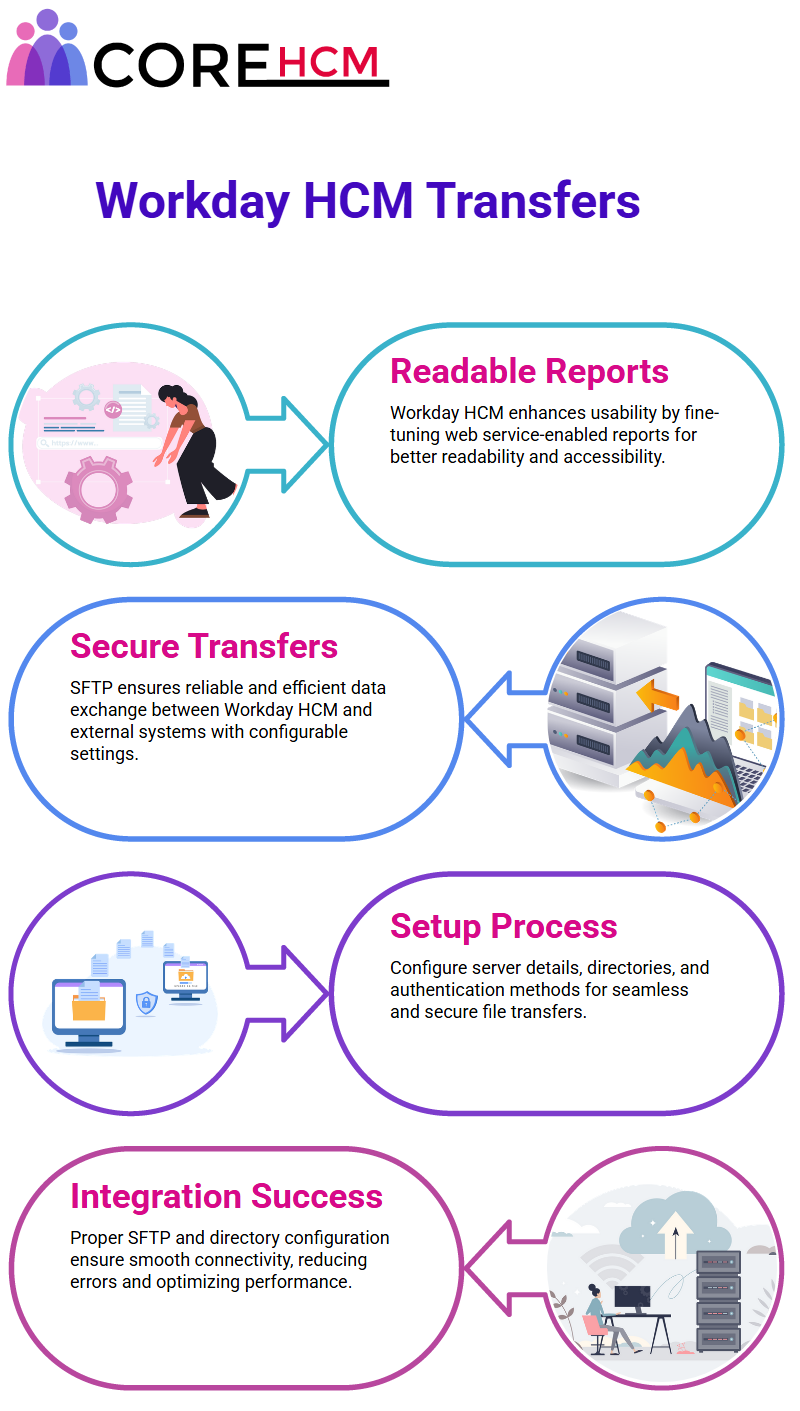
Configuring Multiple Destinations in Workday HCM
Workday HCM offers you the capability of configuring multiple destinations. One destination might focus solely on production while others like “Workday Attachment” could serve training needs.
Launch and Review Integrations in Workday HCM
With all aspects configured, the next step should be launching and reviewing integrations in Workday HCM.
Navigating to the actions related to your integration, selecting Launch or Schedule and clicking to begin should do it for you.
Before finalizing anything, it is a good idea to review your setup carefully as any necessary modifications can always be adjusted later.
Configuring and Testing SFTB Locations
Let’s walk through how to set up and test an SFTB location in Workday HCM, simulating testing if we could access and connect to specific folders or not.
At first, testing transport within Workday HCM involves validating credentials. When these are valid, connection should take place seamlessly
Workday HCM Training in Hyderabad includes hands-on sessions for setting up and testing SFTB connections, making it easier to practice in simulated environments.
Clicking ‘Test Transport’ presents multiple options; as though your computer were asking: ‘What should we test next? Are we ready to run through an SFTB server test?” Here, the primary goal is ensuring connectivity.
If the username or password provided are invalid, a connection test will fail, in which case contact the owner of SFTB server to address issue.
Once valid credentials are supplied Workday HCM will provide confirmation with “connect to endpoints successful message.”
Navigating Workday HCM Integrations for Enhanced Efficiency
Navigating Workday HCM Integrations for Greater Efficiency We now move onto exploring integration options within Workday HCM.
To start off our explorations we must access relevant actions and search for compatible integration systems.
Workday HCM Training in Hyderabad also focuses on helping professionals become proficient in navigating Workday HCM integrations, ensuring optimal productivity and accuracy.
Know how to find what you need easy with integration prefixes like ‘INTSYS.’ For instance, searching the WW field leads us directly to an EIB we have set up; from there it’s just a matter of taking any related actions.
Helps to make testing integrations simple by offering two options for testing: “Run Now,” or leaving blank details such as file name or document retention policies, or just selecting them manually.
As this process runs in the background, refresh to monitor its progress – remarkable enough, many tasks often complete within seconds.
Workday HCM makes it simple and quick to save and review output files – even those written in an XML format – for review and storage.

